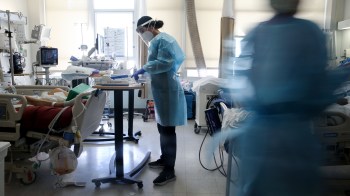Medical scribe industry thrives
Think about the word, “scribe.” What pops into your head? Probably something from a humanities class in college or a History Channel documentary, right?
If you’ve visited a doctor lately, you might envision something more modern. The medical scribe industry has been booming in recent years, fueled largely by hospitals around the county switching to electronic medical record systems.
Tyrell Kirchhefer is the lead scribe in the emergency department at Cheyenne Regional Medical Center in Cheyenne, Wyoming. While the doctor on duty quizzes a patient, he stands silent in the back, taking exhaustive notes on his laptop.
“One of the biggest things they taught us [in medical scribe training] was not to show any facial expressions when you are in the room,” he says. “It takes a lot of work.”
Kirchhefer makes $13 an hour, and the work counts as “hands-on experience” on medical school applications, which he hopes to start submitting soon. He says that after more than a year behind his laptop in the ER, he’s been able to see the gamut of common medical experiences, and some that are not so common.
“I had a woman that was herding cattle one day and, somehow, she was run over by one of the bulls. She didn’t come in for 12 hours or something like that, because she didn’t think it was that bad. It was pretty bad: she had a wound the size of a large orange or a grapefruit.”
The hospital had to adopt electronic medical records by this year in order to not get penalized on medicare and medicaid reimbursement.
These records are much more comprehensive than the paper files or computer spreadsheets the hospital used to use. They also take much longer. Cheyenne Regional ER Doctor Amy Tortorich says it take her about 10 minutes per patient. She usually sees about 30 patients a day.
“That’s an extra five hours charting. So half my shift, almost half my shift.”
But with Kirchhefer she says she can see more patients, and they generally leave happier. Which, Tortorich says, makes medical scribes well worth their cost.
“All of my doctor friends want this.”
That kind of demand has created a booming industry. Sarah Lamb is the Chief Operations Officer for Scribe America, one of the biggest medical scribe companies in the country.
“In the past year alone we have tripled our growth to probably just under 7,500 employees in 47 states.”
The leading scribe trade group predicts the number of scribes working in America will go from about 20,000 today to 100,000 by 2020.
“Unless we have some futuristic component where a physician can do live documentation while walking down the hall, there will always be a need for scribes,” Lamb says.
Wait, why can’t that vision come true? Well there is one big obstacle: the medical scribe industry.
“By creating a new profession we are bypassing the physician,” says Dr. George Gellert, Medical Informatics Officer at Christus Health Systems. “ As well as hospitals and clinics across the country [for their] input into this product.”
Dr. Gellert recently wrote in the Journal of the American Medical Association that, in fact, it’s in our best interest that doctors to have to deal with electronic medical record systems, even if they are frustrating. Gellert says right now electronic medical records are sort of like cell phones in the 90s—clunky and time consuming. Input from cellphone users on what worked and what didn’t was the push that eventually led to the smartphone.
“But if someone was there to manage all [your] cellphone functioning, would there have been the pressure to evolve cell phones? I suspect not.”
One day medical scribes might be innovated out of a job, but for now, many hospitals find them indispensable. In Cheyenne, Kirchhefer says his shop is always hiring.
There’s a lot happening in the world. Through it all, Marketplace is here for you.
You rely on Marketplace to break down the world’s events and tell you how it affects you in a fact-based, approachable way. We rely on your financial support to keep making that possible.
Your donation today powers the independent journalism that you rely on. For just $5/month, you can help sustain Marketplace so we can keep reporting on the things that matter to you.


















